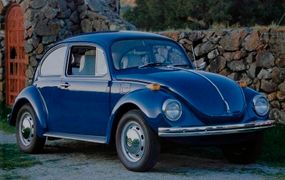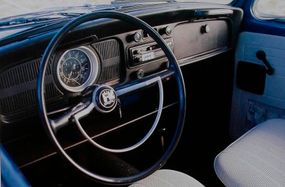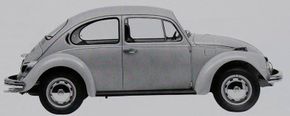1970-1972 Volkswagen Beetle
The 1970-1972 Volkswagen Beetle faced a flood of challenges, including a rising price, a stale design, fresher competitors, and ever-more-stringent safety and emissions standards.
In 1971, Volkswagen of America ran an ad in which a Beetle-shaped squiggle appeared above the words, "How much longer can we hand you this line?" As it turned out, the question had two answers: "not much" and "indefinitely."
Advertisement
The latter referred to developing nations, where the Beetle remained viable as a simple, low-cost car able to cope with all sorts of adverse conditions -- a Volkswagen in the best, original sense. But to the more affluent, demanding buyers of North America and Western Europe, the Beetle was becoming irrelevant.
For one thing, it was becoming expensive, thanks to the strong German economy it had helped create. Though base price had been a low $1,575 as recently as 1966, a steadily appreciating D-mark pushed it to $1,874 by 1970 and close to $3,500 by 1976.
At the same time, a raft of safety and emissions rules were threatening to legislate the car out of existence on both sides of the Atlantic. Volkswagen Beetle ownership was no longer so special either, as rival manufacturers had copied the consistent look and customer-friendly sales and service pioneered by VW dealers.
But mostly, the 1970-1972 Volkswagen Beetle was just an old design with only fuel economy, workmanship, and durability to recommend it. "If you value [those] virtues above all others, then the Beetle is for you," said Road & Track in 1971. "Otherwise, it is hopelessly outdated and outdone by both Japanese and American economy cars."
To its credit, Volkswagen did what it could to keep the Volkswagen Beetle from falling even further behind.
Key changes for American and European 1970 Volkswagen Beetle models included an engine increased to 1600 cc (as on Type 3), and horsepower increased to 57. The models also adopted an ignition-key warning buzzer and larger front turn signals.

The 1971 Volkswagen Beetle's horsepower was bumped to 60, taillamps were enlarged again, and flow-through ventilation was adopted. The 1971 Volkswagen Super Beetle (1302S in Europe) was introduced, with coil-spring MacPherson-strut front suspension, 3.2-inch longer nose, 0.8-inch longer wheelbase, 11.1-gallon gas tank (versus 10.6), 3 cubic-feet more trunk space, and a reduced turning circle. Also that year, a stripped base sedan was added as the $1,845 price leader.
During this period, Volkswagen also tried propping up Volkswagen Beetle sales with a time-honored ploy: special editions. The first was 1972's "Baja" kit for Super sedans, a $130 dealer-installed package of side stripes, short-throw shifter, fog lamps, leatherette steering-wheel cover, mag-style wheel covers, walnut dash appliqué, and tapered exhaust tips.
The 1972 Volkswagen Beetle lineup also adopted a larger rear window, four engine-lid cooling slots (versus two), a revised speedometer and control stalks, and a hinged parcel shelf behind the back seat.
Amidst the gloom of slumping sales, Volkswagen nonetheless had reason to celebrate. Early in 1972, total Volkswagen Beetle sales topped 15,000,000, surpassing those of the Ford Model T to earn the bug the title of "world's most popular car."

For more great articles and pictures on new and classic Volkswagens, see:
- Volkswagen Beetle
- New Volkswagen Prices and Reviews
- Used Volkswagen Prices and Reviews
